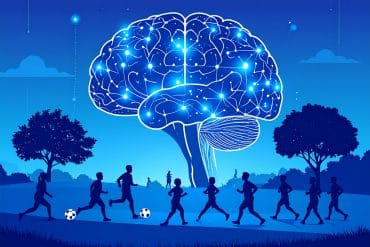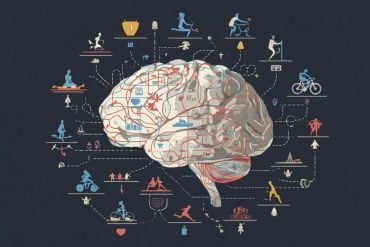Summary: Inconsistent sleep patterns are linked to a decline in attention and cognition, especially in younger adults, a new study reports.
Source: Baylor University.
‘Most students think they’re getting more sleep than they are,’ Baylor University researcher says.
Skimping on sleep, followed by “catch-up” days with long snoozes, is tied to worse cognition — both in attention and creativity — in young adults, in particular those tackling major projects, Baylor University researchers have found.
“The more variability they showed in their night-to-night sleep, the worse their cognition declined across the week,” said study co-author Michael Scullin, Ph.D., director of Baylor’s Sleep Neuroscience and Cognition Laboratory and assistant professor of psychology and neuroscience in Baylor’s College of Arts & Sciences.
“When completing term projects, students restrict sleep, then rebound on sleep, then repeat,” he said. “Major projects which call for numerous tasks and deadlines — more so than for tests — seem to contribute to sleep variability.”
The study of interior design students is published online in the Journal of Interior Design. It also has implications for art, architecture, graphic design and other disciplines that use a model of design studio-based instruction, researchers said.
Interior design is “a strange culture, one where sleep deprivation is almost a badge of honor,” said lead author Elise King, assistant professor of interior design in Baylor’s Robbins College of Health and Human Sciences.
Staying up late to work on a project is not seen as procrastination but considered by some students and faculty members to be a tradition and a normal part of studio-based curricula to prepare them for their careers, she said.
“Since the general public still doesn’t understand the profession of interior design, and mistakenly thinks we’re the same as decorators, there is a sense that you want to work harder and prove them wrong,” King said. “But recently, we’ve seen the consequences of that type of thinking: anxiety, depression and other mental health issues — and also the dangers of driving while sleep deprived.”
The study challenges a common myth — that “the best design ideas only come in the middle of the night,” King said. But researchers found the opposite — that “consistent habits are at least as important as total length of sleep,” Scullin said.
Irregular sleep is a negative for “executive attention” — intense focus for planning, making decisions, correcting errors and dealing with novelty. Erratic sleep also has a negative effect on creativity, the study found.
The National Sleep Foundation recommends that young adults have seven to nine hours of sleep each day. But for the 28 interior design students in the Baylor study, sleep was short and fragmented. Only one participant slept seven hours or more nightly; 79 percent slept fewer than seven hours at least three nights during the week.
“Most students think they’re getting about four more hours of sleep each week than they actually are,” Scullin said.
“Projects are often lengthy, with final due dates looming weeks or months in the future,” King said. “The stress of juggling several projects, each with multiple deadlines, is likely to contribute to students’ tendency to cycle between several days of poor sleep leading up to a project due date, followed by a catch-up day with 10 or more sleep hours.”
Researchers measured sleep patterns through actigraphy, with students wearing wristbands to track movement. Students also kept daily diaries on the quantity and quality of their sleep.
“The wristband is somewhat similar to Fitbit devices, but much more reliable in detection, including the many brief awakenings during sleep that affect sleep quality,” Scullin said.
All participants completed two cognitive testing sessions for creativity and executive attention — each about an hour long and in a laboratory. The sessions were done on the first and last day of the study at the same time of day.
“What we call ‘creativity’ is often people’s ability to see the link between things that at first glance seem unrelated, and one of the tests taps into that ability,” Scullin said.
An example: participants are given three words that are loosely connected — such as “sore,”‘ “shoulder” and “sweat” — and asked to figure out a fourth word that would connect them all.
“What first comes to mind are words related to exercise, but in this case, no single exercise word really works. Instead, the ‘creative’ and correct answer is ‘cold,'” Scullin said.
Meanwhile, executive attention — “working” memory — enables people to hold memories for a short time while doing a separate task. In the study, participants completed a task in which they saw a grid with black and white squares.

“They had to decide very quickly whether that grid was symmetrical or not. Symmetry decisions by themselves are easy,” Scullin said. “But after each decision, participants were shown a grid with one square highlighted in red. Then they made another symmetry decision, followed by a different square highlighted in red. They repeat that cycle up to five times before being asked to recall all the square locations in the correct order. It’s very challenging to cycle between those two tasks and keep the square locations in mind.”
Further investigation with a greater range of students across multiple studio-based majors and multiple universities would be valuable, researchers said.
“Interior design programs are changing,” King said. “People are open to the conversation and willing to discuss ways to reduce that pressure on our students and encourage them to be healthier.”
Source: Terry Goodrich – Baylor University
Image Source: NeuroscienceNews.com image is in the public domain.
Original Research: Abstract for “Sleep in Studio Based Courses: Outcomes for Creativity Task Performance” by Elise King, Mericyn Daunis, Claudina Tami and Michael K. Scullin in Journal of Interior Design. Published online April 21 2017 doi:10.1111/joid.12104
[cbtabs][cbtab title=”MLA”]Baylor University “Inconsistent Sleep Scheduel Harms Attention and Creativity in Young Adults.” NeuroscienceNews. NeuroscienceNews, 24 April 2017.
<https://neurosciencenews.com/sleep-creativity-attention-6485/>.[/cbtab][cbtab title=”APA”]Baylor University (2017, April 24). Inconsistent Sleep Scheduel Harms Attention and Creativity in Young Adults. NeuroscienceNew. Retrieved April 24, 2017 from https://neurosciencenews.com/sleep-creativity-attention-6485/[/cbtab][cbtab title=”Chicago”]Baylor University “Inconsistent Sleep Scheduel Harms Attention and Creativity in Young Adults.” https://neurosciencenews.com/sleep-creativity-attention-6485/ (accessed April 24, 2017).[/cbtab][/cbtabs]
Abstract
Sleep in Studio Based Courses: Outcomes for Creativity Task Performance
Good sleep quality is important to cognition, physical health, mental well-being, and creativity—factors critical to academic and professional success. But, undergraduate students often report engaging in short, irregular, and poor-quality sleep. Anecdotal and questionnaire data suggest that poor sleep habits might be prevalent in students who are in studio- or project-based majors that implicitly encourage consecutive nights of disrupted sleep to complete projects. We investigated sleep quantity and quality using both objective measures (wristband actigraphy monitoring) and subjective measures (sleep diary) in 28 interior design undergraduate students for a 7-day period. Our primary aim was to measure sleep quantity (total sleep time) and quality (e.g., nighttime awakenings) and to compare whether undergraduate interior design students’ objective measures of sleep (actigraphy) differed from their subjective measures (sleep diary). The secondary aim was to investigate detrimental outcomes of poor sleep habits on laboratory-based measures of cognitive function (symmetry span, prospective memory, Raven’s progressive matrices, remote associates task) that were administered pre- and poststudy. We found that the interior design students in our study overestimated their total sleep time by 36 minutes, that 79% of students slept for fewer than 7 hours at least three nights per week, and that many students cycled between nights of restricted/short sleep and recovery/long sleep. Importantly, students who maintained short sleep durations, highly variable night-to-night sleep durations, or had fragmented sleep (i.e., waking after sleep onset) demonstrated pre- to poststudy declines on the laboratory measure of creativity (remote associates task). These findings suggest the need for further investigations, which may lead to a broader discussion of studio culture and the role of the “all-nighter,” both in professional practice and in design education.
“Sleep in Studio Based Courses: Outcomes for Creativity Task Performance” by Elise King, Mericyn Daunis, Claudina Tami and Michael K. Scullin in Journal of Interior Design. Published online April 21 2017 doi:10.1111/joid.12104






